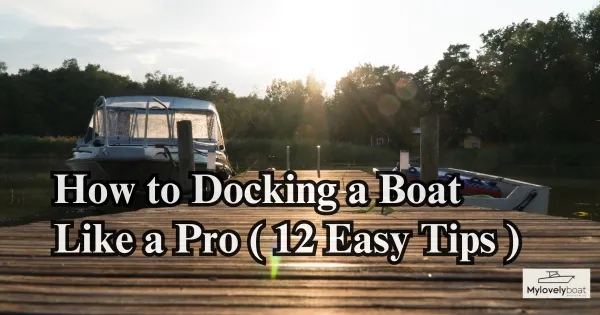
Docking a boat can be intimidating and stressful, especially for those just getting started. But learning how to dock a boat doesn’t have to be complicated; new and old boaters can quickly master the task by following these simple tips.
- Prepare your boat
- Plan Your Approach
- Approach gradually and at an angle
- Understand the Wind and Current
- Use Fenders
- Use your senses
- Keep a safe distance
- Practice Steering Abilities
- Practice Communicating
- Prepare Dock Lines
- Secure the Boat Properly
- Practice makes perfect
1# – Prepare Your Boat
Before docking, ensure all necessary equipment is ready and easily accessible. This includes fenders, dock lines, and any tools you might need. Check that the fenders are at the correct height to protect your boat’s hull and that dock lines are prepared on the bow and stern. This pre-arrival preparation prevents rushing and mistakes when you’re close to the dock, ensuring a smoother docking process.
2# – Plan Your Approach
Assess the docking area from a distance. Note the location of your designated spot, any obstacles, and the direction of other boats. Decide your approach path, considering the wind, current, and available space. Planning your approach reduces last-minute maneuvers and increases safety for you, your passengers, and other boaters. Always have a Plan B if your initial approach needs to be aborted.
3# – Approach Gradually and at an Angle
When approaching the dock, it’s best to do so slowly and at a slight angle. This method gives you more control, allowing you to adjust your path as needed. A gradual approach minimizes potential damage to your boat and the dock. If you miss the approach or something goes wrong, correcting your course without rushing is easier. Always be prepared to reverse and retry if the approach doesn’t go as planned.
4# – Understand the Wind and Current
Being aware of wind direction and current is crucial when docking. They can help you get to the dock or make it more challenging. If the wind or current pushes you towards the dock, you may need to approach at a less steep angle. Conversely, if they pull you away, you might have to come in more aggressively to ensure you reach the dock. Adjust your speed and approach angle to use these natural forces to your advantage.
5# – Use Fenders
Position fenders on the side of your boat that will face the dock, ensuring they hang at the right height to effectively absorb impacts and prevent damage to both your boat and the dock. Fenders act as a cushion during docking, especially in tight spaces or when unexpected movements occur due to wind or current changes. Adjust their positions based on the dock’s height and your boat’s specific docking location for optimal protection.
6# – Use Your Senses
Rely on your sight, hearing, and touch when docking. Keep your eyes on the surroundings, not just the dock, to avoid obstacles and monitor other boats. Listen for any unusual sounds that might indicate a problem, such as scraping or the sound of water indicating a stronger-than-expected current. Feel the boat’s response to your steering inputs and the wind and current effects. Integrate all this information to make smooth, informed docking maneuvers.
7# – Keep a Safe Distance
Maintaining a safe distance from other docked boats and obstacles allows you room to maneuver and correct your course without risk of collision. It also gives you time to assess and react to sudden changes in wind or current that could affect your approach. A good rule of thumb is to keep at least one boat length’s distance from any obstacles until you’re ready to make your final approach.
8# – Practice Steering Abilities
Good docking comes from practice and a deep understanding of how your boat responds to steering inputs under different conditions. Practice in various scenarios, including calm and rough waters, to build confidence. Pay attention to how your boat behaves when moving forward, in reverse, and utilizing the throttle and steering adjustments at low speeds. This understanding and experience will significantly reduce stress during the docking process and enhance safety.
9# – Practice Communicating
Clear and concise communication with your crew and dock attendants is key to successful docking. Assign roles and use established boating signals or phrases to coordinate actions. Practice beforehand to ensure everyone understands their duties, from handling lines to fender placement. Good communication helps prevent misunderstandings and errors during docking, especially when quick responses are needed in changing conditions.
10# – Prepare Dock Lines
Before you reach the docking area, have all your dock lines ready and coiled for quick deployment. Assign crew members to handle specific lines and instruct them where to secure them on the dock. Bow, stern, and spring lines should be prepared for both the port and starboard sides of the boat in case you need to dock on the unforeseen side. Properly managed lines help smooth the transition from approach to being fully docked.
11# – Secure the Boat Properly
Once your boat is alongside the dock, secure it promptly with bow, stern, and spring lines. The order in which you secure these lines can vary depending on the situation. Still, generally, the bow line is secured first to prevent the bow from drifting away, followed by the stern and spring lines to prevent forward and backward movement. Ensuring your boat is tied securely to the dock prevents damage and maintains your vessel’s and passengers’ safety.
12# – Practice Makes Perfect
Repeatedly practicing docking in different conditions and scenarios will build your skill and confidence. Don’t stop practicing on calmer days and in more challenging conditions like strong winds or currents. Each docking experience offers valuable lessons. Over time, you’ll develop an intuitive feel for how your boat handles, leading to quicker, safer docking and a more enjoyable boating experience.
Conclusion
It’s essential to practice docking in different conditions to become proficient. Don’t be discouraged by initial difficulties; docking is an art that takes time to master. As always, follow any specific regulations or advisories in the area where you are boating.
FAQ-
Is docking a boat easy?
Docking can be challenging, especially for beginners, but it becomes easier with practice. Many boaters find that they gain confidence and skill over time, making the process feel more intuitive2.
Why is docking a boat so hard?
Docking is difficult due to factors like wind, current, and limited space. Boats can be unpredictable at low speeds, and maneuvering requires precise control. These challenges can make it stressful, especially in crowded or tricky environments2.
What are the disadvantages of docking?
Disadvantages of docking include the risk of damage to the boat or dock, the stress it can cause for the operator, and the potential for time-consuming attempts if things don’t go smoothly. Additionally, improper docking can lead to accidents or injuries.
Why do boats sink at dock?
Boats can sink at the dock due to issues like poor maintenance, leaks, overloading, or neglect. Sudden weather changes can also cause flooding if the boat isn’t adequately prepared. Regular checks and maintenance are essential to prevent sinking





